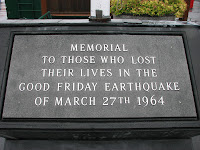1964 Good Friday Earthquake remembered
 It was the earthquake that woke up America, its 9.2 Herculean shaking reverberating through the earth, causing the whole planet to ring like a bell for weeks afterward. Even now, the earth is still moving in response to the "Good Friday Earthquake" that rocked Alaska on March 27, 1964.
It was the earthquake that woke up America, its 9.2 Herculean shaking reverberating through the earth, causing the whole planet to ring like a bell for weeks afterward. Even now, the earth is still moving in response to the "Good Friday Earthquake" that rocked Alaska on March 27, 1964.At magnitude 9.2, this was the second-largest quake ever recorded in the world, topped only by a 9.5 in Chile a few years earlier. Its specter, even 40 years later, haunts not only many of those who lost loved ones or who lived through the four minutes of shaking or the quake’s legacy of tsunami waves surging into cities and destroying communities, but also those responsible for earthquake monitoring and safety.

Research conducted after the quake revealed that on March 27th, 1964, at 5:36 p.m., the crustal plates beneath southern Alaska could resist the strain no longer. The Pacific Plate pushed an average of 30 feet beneath the North American Plate, unleashing the pressure the two masses had built up by pushing against each other for centuries. The shock was roughly equivalent to 100 million tons of TNT exploding — or the force of about 63,000 atomic bombs the size of the one dropped on Hiroshima. The
 quake ripped a sub-sea fault 500 miles long (800 km) and 125 miles wide (200 km).
quake ripped a sub-sea fault 500 miles long (800 km) and 125 miles wide (200 km).Its effects seem almost biblical in their scale and are a cautionary story not only for Alaska but also for the other 39 U.S. states most at risk of destructive earthquakes. The sea floor immediately rose 36 feet in some places, generating the birth of gigantic tsunami waves that struck the Pacific coast, killing people as far south as Crescent City, California. In all, 131 deaths occurred, most caused by huge tsunami waves that surged into and devastated coastal communities such as Valdez, Seward, Chenega, and Kodiak. Locally, these waves ran up as far as 220 feet high. It was only because the earthquake occurred late in the day of a holiday and in a less populous region that loss of lives and property were not considerably higher.
By all accounts, the March 27, 1964, Good Friday earthquake and the tsunamis that followed in its wake were simply terrifying, an ordeal to be endured. The quake not only left behind scars still visible on the land, but it also left wounds for those who lost family members and friends in the quake or the tsunamis, some of the victims children.
As the earthquake’s first seconds jolted Alaska, the sea floor immediately rose some 36 feet in some places, triggering a huge tsunami that hit the Pacific coast, killing people as far south as Crescent City, Calif. Locally in Alaska, these waves ran up as far as 220 feet high. One eyewitness reported the water rising 15 feet in 5 seconds in Kodiak, Alaska.
In all, 131 deaths occurred, most caused by huge tsunami waves that surged into and devastated coastal communities such as Valdez, Seward, Chenega, and Kodiak. In Valdez, 32 people died in as a result of a tsunami caused by an underwater landslide; tsunamis generated by the earthquake also killed 23 people in the village of Chenega, 12 people in both Whittier and Seward, and 8 in Kodiak.
A combination of shaking, tsunamis, landslides, and liquefaction destroyed buildings, houses, roads, and other infrastructure. Coastal land-level changes of as much as 36 feet of uplift occurred in one area and 6 feet of subsidence in another over a region two-thirds as large as the state of California. This great earthquake was felt over a half million square miles and resulted in at least $350-500 million in property damage in Alaska in 1964 dollars, a figure around $2 billion today.
The effects of the earthquake were also felt worldwide — boats off the Gulf Coast of Louisiana sank from the sloshing of water resulting from the quake’s force, and the earthquake was recorded on tide gages in Cuba and Puerto Rico. Even wells in Africa sloshed from the reverberating seismic waves.
Earthquake damage was heavy in many towns, including Anchorage, Chitina, Glennallen, Homer, Hope, Kasilof, Kenai, Kodiak, Moose Pass, Portage, Seldovia, Seward, Sterling, Valdez, Wasilla, and Whitter. Anchorage, about 75 miles northwest of the epicenter, also sustained severe damage. About 30 blocks of dwellings and commercial buildings were damaged or destroyed in the downtown area of Anchorage. Some schools were almost devastated. An area of about 130 acres was devastated by displacements that broke the ground into many deranged blocks that were collapsed and tilted at all angles. This slide destroyed about 75 private houses. Water mains and gas, sewer, telephone, and electrical systems were disrupted through the area.
In Valdez, 32 people died in as a result of a tsunami caused by an underwater landslide; tsunamis generated by the earthquake also killed 23 people in the village of Chenega, 12 people in both Whittier and Seward, and 8 in Kodiak.
In the first day there were 11 aftershocks with magnitude greater than 6.0; in the next three weeks there were 9 more. Residents endured thousands of aftershocks in the months following the quake, and felt smaller aftershocks for more than a year.
Photo's from Seward Welcome Center
Research info from USGS
Comments